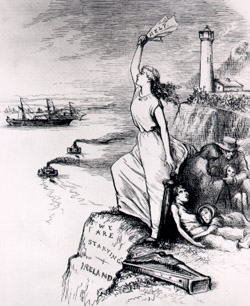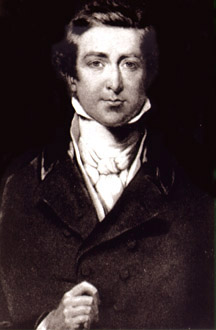from
Plant Diseases: Their Biology and Social Impact.
The Birth of Plant Pathology
The history of the scientific study of the blight is well chronicled in E. C. Large's popular book The Advance of the Fungi. Some of the important characters in this drama should be mentioned. The fungus found on the potatoes was first described and named by Dr. C. Montagne, a French physician in Napoleon's army. He shared his observations with Rev. M. J. Berkeley, in England, who recognized that this new fungus was probably connected with the blighting in some way. Berkeley's rival was Dr. John Lindley, a botany professor at University College in London, who did not believe that the fungus was the cause of the blight. Their arguments, published in a periodical called The Gardener's Chronicles, reflected some of the most intense philosophical arguments among scientists throughout Europe. Were the rusts, smuts, and other fungi a product of diseased tissue or could they be the cause of the disease itself?

Fig. 1-14. A political cartoon printed in the United States at the time of the Irish potato famine.
While those of better means argued and philosophized, the Irish were starving. Food was in short supply the first winter, leaving fewer seed potatoes to be planted the next season. The summer of 1846 brought new hope as the plants began green and healthy, but the blight came again and destroyed any hope of a better winter. Help from England was slow to come. It was difficult to convince landowners that this famine was any worse than those that periodically left the poor hungrier than usual. Grain, and other food collected for rent, was exported from Ireland throughout the blight years. These cruelties and their political consequences are well described in The Great Hunger by Cecil Woodham-Smith.
An important character in the political drama was Sir Robert Peel, the English prime minister, who used the blight as an excuse to repeal protectionist trade laws by requesting the import of American maize (corn) to feed the hungry Irish. The corn mash was cooked in open kitchens, often miles from the villages. Those too weak or sick to walk to the food had to share the portions of the stronger ones. The cooked mush also prevented the sale and distribution of the grain on a black market. The rations were dubbed "Peel's Brimstone" by the recipients, who were considered ungrateful since food was not only provided but cooked for them as well. The rainy weather and resulting blight continued throughout what came to be called "The Hungry Forties." Poor people throughout Europe found themselves hungry because of the severe losses in the potato crop and increased prices of other foods. It was a time of economic depression and political unrest. The Communist Manifesto was published in 1848. Nowhere was the suffering as grim as in Ireland, however, and in a 15-year period, the Irish population of 8 million decreased by at least 1 million due to disease and starvation and an additional 1.5 million due to emigrants who found a way to leave the island, many traveling to the United States and Canada.

Fig. 1-15. Sir Robert Peel, Prime Minister of England during the Irish potato famine.
The scientific philosophers were unable to save the potato crops or prevent the blight in succeeding years, but from this disaster came an important new understanding of plant disease. Anton deBary, a German botanist, performed the experiments that proved the role of the fungus in the blight. He subjected potato plants to the cool, wet environmental conditions that favored blight. To some plants he applied sporangia from blighted plants, but others he kept as "control" plants and applied no fungus. Even though both sets of plants were exposed to the same favorable environment, only the plants inoculated with the fungus became blighted. It was clear that the plants did not rot away because they absorbed too much water. In the absence of the pathogen, no disease occurred. It is important to appreciate the intellectual significance of deBary's experiments. They triggered major advances in the study not only of plant diseases but also of human and animal diseases, due to a new understanding of the importance of contaminated food and water and unsterilized medical instruments in infectious and contagious diseases. For 200 years, people had been observing many disease-causing organisms, but these had been seen as the result, rather than the cause, of disease. Scientists were now prepared to abandon the theory of spontaneous generation for Louis Pasteur's germ theory of disease, which he proposed in 1863.

Fig. 1-16. Anton deBary.
The blight fungus was recognized as new to Europe. Like all other organisms, the fungus has a Latin binomial. It was first named Botrytis infestans by Montagne, but the name was changed to Phytophthora infestans by deBary. In a formal designation of a Latin name, initials follow the name to allow one to find the description of the organism that is officially recorded at the time of the naming. Many plant and animal names are followed by "L." because Linnaeus first created the system and named many of the commonly known plants and animals. Most of those names were well accepted because the organisms were already familiar and well studied. Names of less familiar organisms are often changed as their biology and relation to other organisms become better understood. This is particularly true of microorganisms because of the rapid improvements in the technology for their culture and study. In such cases, the specific epithet usually remains, but the genus is changed. The name of the original describer is then put in parentheses, followed by the name of the new describer. For example, the potato blight fungus is now called Phytophthora infestans (Mont.) deBary. Montagne's specific epithet, infestans, was retained, but deBary realized that the fungus was not really similar to other species in the genus Botrytis, so he created the genus name Phytophthora to describe the blight fungus.
Linnaeus used Latin to describe organisms because that was the international language of educated Europeans. Many of the names can be translated from their Greek and Latin roots to reveal the ideas of the describers. Phytophthora comes from the Greek (phyto = plant and phthora = destroyer), and the species name, infestans, suggests the devastating infestation. People use common names for their plants and animals in their various languages, but scientists communicate internationally using the Latin names. Most microorganisms have no common names because usually no one but a scientist observes or talks about these species.
DeBary's work led many scientists to observe diseased plants and describe the parasitic fungi associated with them. Of course, the presence of a fungus in diseased tissue is not proof that it is the primary causal agent in the disease. In fact, most fungi are incapable of parasitizing healthy plant tissue and can invade only dead plant tissue. Some means was necessary to determine whether a fungus present on a diseased plant had caused the disease or was simply an opportunistic saprophyte, that is, an organism that obtains its nourishment from nonliving organic matter.
The proof of pathogenicity was derived from work by a German microbiologist named Robert Koch, who worked with anthrax disease of sheep. By chance, the bacteria that cause anthrax are particularly large and were visible even with 19th century microscopes. Koch created a process to convince himself and others that the bacteria in the blood of the cattle actually caused the anthrax disease. Koch's postulates, which can be applied to diseases of plants as well as animals, include the following steps:
1) The symptoms and any evidence of the pathogen in the diseased host are carefully described.
2) The suspected pathogen is isolated from the diseased host and from all other contaminating microorganisms, usually on a nutrient medium that will keep the organism alive. A description is made of the suspected pathogen.
3) A healthy host is inoculated with the suspected pathogen. It is later observed for symptoms, which must be identical to those described in Step 1.
4) The pathogen is reisolated from the inoculated host and must be identical to the organism described in Step 2.
When all four steps are completed, the proof of pathogenicity is established. These rules continue to guide our studies of new diseases, although modifications must be made for pathogens that cannot be cultured outside a living host. New disease reports published today still frequently indicate that Koch's postulates have been fulfilled in the described experiments.
Following deBary's work with P. infestans, other scientists began to report numerous fungi capable of infecting plants and causing disease. In the early years, bacteria seemed to be associated mostly with animal and human diseases, and an inaccurate separation of pathogens was created by scientists too quick to look for differences between plants and animals. Near the end of the 1800s, however, bacteria were also shown to be plant pathogens--but only after intense argument. Plant pathology, the study of plant diseases, had become an important part of scientific study.
Introduction
The Arrival of the Potato in Europe
The Potato Plant
The Components of the Epidemic
The Birth of Plant Pathology
Protecting Potatoes from the Blight
Lessons from the Potato Famine
Selected Readings
RETURN TO APSnet FEATURE STORY
